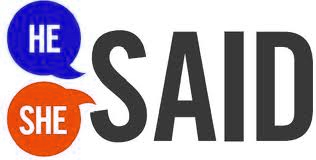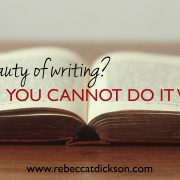He said. She said. And they all lived happily ever after.
And at the beginning, the writer had dialogue, and it was awesome. It sucked me in like nothing I’ve read in ages. But as much as I loved the writing and banter, by the fifth or sixth response from character number one to character number two, I wanted to bleach my eyeballs.
“He would write his quote this way,” she scoffed.
“And I wanted to yell at him, loud and long,” she sneered.
“Because no one – no one – can scoff, sneer, gasp, grumble, hesitate, blurt or even cry words,” she snapped.
We don’t snap words either.
Here’s the deal:
When your characters speak, they say things. He said. She said. Sometimes, they whisper, mutter or ask. Anything else – any other, more colorful verb you mistakenly believe will enliven your dialogue – is a way of telling the reader instead of showing.
Why?
I’m so glad you asked. Two reasons.
First, colorful verbs distract the reader from what’s important, which is your fucking dialogue. Don’t mess with that.
 Second, it defies physics to scoff or gasp, etc., words. We can end a quote with “he said, scoffing.” or “she said, gasping.” or “she said, smiling” – you get the idea. But as writers, it is our job to SHOW the reader what we mean. We want our readers to see what we see. One of the best ways to do that is by describing facial expression and/or body language.
Second, it defies physics to scoff or gasp, etc., words. We can end a quote with “he said, scoffing.” or “she said, gasping.” or “she said, smiling” – you get the idea. But as writers, it is our job to SHOW the reader what we mean. We want our readers to see what we see. One of the best ways to do that is by describing facial expression and/or body language.
“I am not lazy,” she said, furrowing her brow. (anxious)
“You are too,” he said, clenching his fists. (angry)
“Not nearly as lazy as your sister,” she said, looking down her slender nose at him with distaste. (scoffing)
The point: Dig deeper.
If we meet somewhere and chat, your face is the first thing I see. It’s also the focal point. People connect via eye contact. We notice when her eyes widen, squint, focus inward or dart. We also watch her mouth. We see right away when she presses her lips, flashes teeth, frowns, smiles or purses her lips.
And let’s not forget the rest of the body. We see and make note of gestures as we talk. Writers can describe thousands of movements to show readers what the character feels or how he says something. All readers – all people – are body language experts.
Ninety-three percent of human communication is nonverbal. Think about it. We are regularly fed messages through body movement. What we sense as we interact dictates how we feel and how we act toward the other person.
Readers naturally apply this skill and recognize body language on the page. The way a gesture is described reminds them of how they use a similar movement when experiencing an emotion. It’s called shared experience, and it’s what powers the elusive empathy link between reader and character. Combine your rich dialogue with pieces of a character’s thoughts, and it’s pretty easy to convey a powerful moment.
But it’s not going to happen with Susan scoffing at the end of every quote, while Steve whimpers his replies. Add flavor with description.
When in doubt, pick up a book from your favorite author and look at how they end their dialogue. J.R.R. Tolkien, Leo Tolstoy, Jane Austen, Charles Dickens, Robert Louis Stevenson, Kurt Vonnegut, Victor Hugo, F. Scott Fitzgerald, for starters – all end quotes with said, say, or some variation referring to volume. Modern-day authors? George R.R. Martin, Anne Lamott, Tana French, Eoin Colfer, Pittacus Lore, Rick Riordan. Go look.
• • •
Need help? Hit me up. I’m available for one-on-one writing guidance, consults and full edits.
Psst. Be sure to subscribe to the site in the upper right-hand corner. That way, I can send the sexiest, most liberating and inspiring tidbits of writing advice straight to your inbox.







I love writing dialog. Sometimes I have to force myself to pull back just to keep a good balance. Dialogue allows you to reveal so much about how your characters think and feel. I almost always end it with “said”. Every now and then I’ll do something like, “Stop,” she said, feeling his hand at her waist. I find it more effective to put the action before the quote, though, like: She felt his hand slide to her waist. “Stop,” she said.
I’m OCD when it comes to dialogue, though. I may spend half an evening tweaking a conversation until it sounds natural. My general rule of thumb is to use just enough after someone speaks to let the reader know who is speaking. Nothing kills dialogue faster than losing track of who is saying what. Well, maybe dialogue that sounds contrived, or reads like an English textbook (or someone talking in a TV commercial) is worse.
Good post. Great advice.
Because you’re the Golden Boy, Carl. LOL Most writers don’t understand how critical it is – and how much time it takes – to make dialogue appear natural.
He shook his head and sighed. “Golden Boy? Really?. What’s up with that?”
I know I’m setting myself up for failure most of the time, but I prefer minimal attribution in my dialogue. It forces better dialogue out of me. Rather than “he said, she said”, which I find monotonous, I like to write description or setting. What do you think?
Depends on the situation. Can you give us an example?
http://burnsizzlebleed.blogspot.com/2013/02/northbound-route-40.html
It starts off well, but then gets confusing. All dialogue needs some attribution to help the reader along.
Rebecca, thanks for posting this. I tend to like action with my dialog or make the characters recognizable by their words without need for tags, but I didn’t learn this until I became a writer.
I hope every high school student out there reads it. Teachers in secondary education tend to tell students to use dialog tags and write in third person omniscient. Later on, in college and in the professional world, writers find dialog tags don’t work well and writing in third person omniscient is frowned upon for some genres.
The new trend in elementary school is “said is dead.” They actually want them to use anything else. Makes me crazy.
Hi Rebecca
Great post, thanks.
Couldn’t agree more with your points.
I also think it’s worth mentioning that in one on one conversation, ‘he said’, ‘she said’ can be dispensed with completely for a few lines, allowing the dialogue to flow.
Cheers
Mike
Excellent point, Mike. Thank you for mentioning it. A few lines with two characters doesn’t always need attribution. If only we could just ban the use of “sneered” “scoffed” and “gasped” at the end of a quote. *sigh*
Becky cured me of scoffing up dialgue. She still catches me announcing my characters’ thoughts but I embraced the said movement pretty quickly.
Now I cringe when I see others hiccup their points. And my own writing before RTD? “Yeah,” she sneers. “It’s got a some snapping to do.”